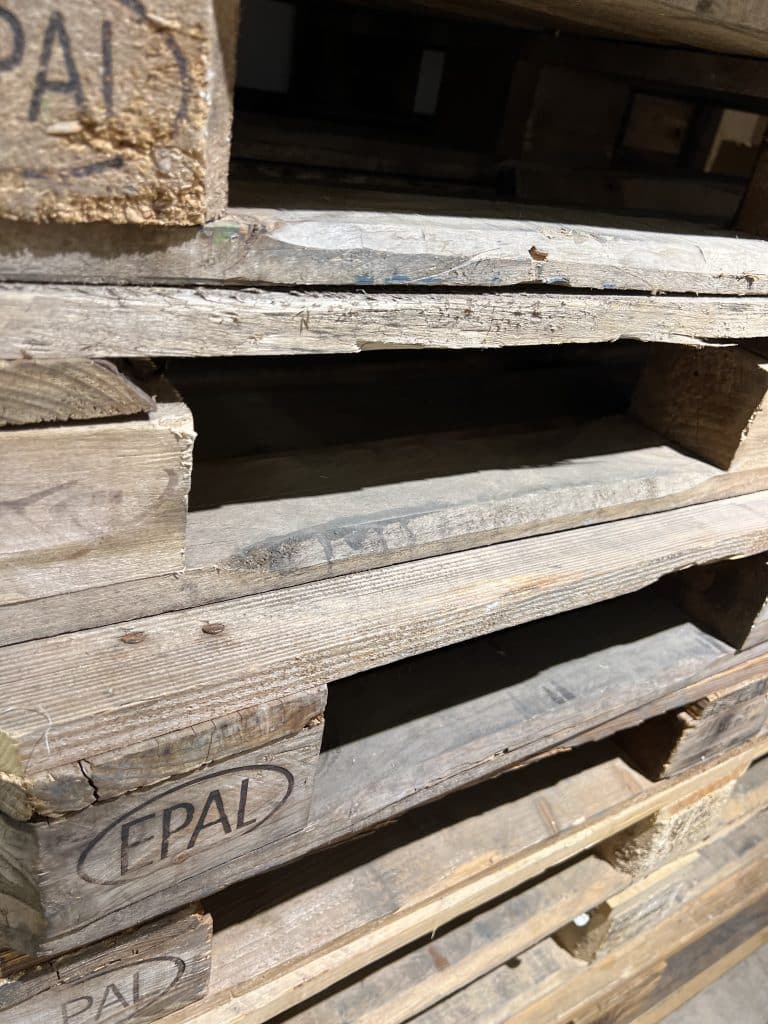EUR pallet (Euro pallets) is a key component in the logistics and transportation industry. They are widely used in Europe and recognized for their standard dimensions, durability, and versatility. As a professional buyer, understanding Euro pallets can help you make informed decisions, optimize your supply chain, and ensure smooth operations.
Table of Contents
What is a EUR Pallet?
A Euro pallet, also known as a EUR pallet or EPAL pallet, is a standardized wooden pallet (primarily made of wood, with some versions in plastic or metal.). The European Pallet Association (EPAL) oversees the production and quality of these pallets. Euro pallets are designed to fit perfectly within European transport and storage systems.
Dimensions:
- Length: 800 mm
- Width: 1,200 mm
- Height: 144 mm
Weight Capacity:
- (Weight: approx. 25 kg)
- Safe working load: 1,500 kg
- Maximum additional load: 4,000 kg when stacking
These dimensions are standardized, meaning every Euro pallet is exactly the same size. This uniformity helps in planning and optimizing storage and transport.
Advantages of Euro Pallets
Standardization: The standard size of Euro pallets ensures compatibility with various handling equipment, such as forklifts and pallet jacks. This makes loading, unloading, and stacking more efficient.
Durability: Euro pallets are made from high-quality wood, which makes them sturdy and durable. They can handle heavy loads and withstand rough handling during transportation.
Reusability: Due to their robust construction, Euro pallets can be used multiple times. This makes them cost-effective and environmentally friendly, as they reduce the need for single-use packaging.
International Recognition: Euro pallets are recognized and accepted across Europe and in many other parts of the world. This facilitates international trade and simplifies logistics for companies operating in multiple countries.
Uses of Euro Pallets
Euro pallets are used across various industries, including manufacturing, retail, and warehousing. They are ideal for transporting and storing a wide range of products, from food and beverages to machinery and electronics.

In Warehouses:
- EUR pallets help maximize storage space. Their standardized size allows for efficient stacking and organization.
- They can be easily moved with forklifts and pallet jacks, speeding up the handling process.
In Transportation:
- Euro pallets fit perfectly in European trucks and containers. This ensures optimal use of space and reduces transportation costs.
- They are also used in intermodal transport, making it easier to transfer goods between trucks, trains, and ships.
Quality and Compliance
EPAL, the European Pallet Association, ensures that all Euro pallets meet strict quality standards. Each pallet is marked with the EPAL logo and other identifying marks, such as the country of origin and the manufacturing date. These markings guarantee that the pallet has been produced according to EPAL’s guidelines.
EPAL pallets are also treated to prevent pests, complying with the International Standards for Phytosanitary Measures (ISPM 15). This treatment involves heating the wood to a specific temperature to eliminate any pests, ensuring that the pallets are safe for international shipping.
Cost Considerations
While Euro pallets might be more expensive upfront compared to non-standard pallets, their durability and reusability make them a cost-effective choice in the long run. They reduce the need for frequent replacements and minimize the risk of product damage during transit.

Summary EUR Pallet
For professional buyers, Euro pallets offer a reliable, standardized, and cost-effective solution for handling and transporting goods. Their durability, reusability, and international recognition make them a preferred choice in the logistics industry. By investing in Euro pallets, you can enhance the efficiency of your supply chain, reduce costs, and ensure compliance with international standards. Understanding the benefits and uses of Euro pallets will help you make informed decisions and optimize your logistics operations.
If you are interested in learning more about the operative buyer role, please visit LHTS’ online bundle of courses Basics for an Operative Buyer.
Extra: How many EURO pallets do a 20 TEU hold?
To determine how many Euro pallets a 20-foot TEU (Twenty-foot Equivalent Unit) container can typically hold, we need to consider the internal dimensions of the container and the dimensions of the Euro pallets.
Euro Pallet Dimensions:
- Length: 47.2 inches (120 cm)
- Width: 31.5 inches (80 cm)
20 TEU Container Internal Dimensions:
- Length: 19.35 feet (5.9 meters) = 590 cm
- Width: 7.7 feet (2.35 meters) = 235 cm
- Height: 7.9 feet (2.39 meters) = 239 cm
Calculating the Number of Euro Pallets:
Floor Space Calculation:
To fit EUR pallet in a 20-foot container, we need to consider two possible orientations:
- Lengthwise: Pallets are placed with the longer side parallel to the length of the container.
- Widthwise: Pallets are placed with the shorter side parallel to the length of the container.
Lengthwise Orientation:
- Number of pallets along the length: 590 cm / 120 cm ≈ 4.91 (approximately 4 pallets)
- Number of pallets along the width: 235 cm / 80 cm ≈ 2.94 (approximately 2 pallets)
Total pallets (lengthwise) = 4 pallets × 2 pallets = 8 pallets
Widthwise Orientation:
- Number of pallets along the length: 590 cm / 80 cm ≈ 7.38 (approximately 7 pallets)
- Number of pallets along the width: 235 cm / 120 cm ≈ 1.96 (approximately 1 pallet)
Total pallets (widthwise) = 7 pallets × 1 pallet = 7 pallets
Considering Both Orientations:
In practical applications, the lengthwise orientation is more commonly used as it typically allows better utilization of space and easier loading/unloading.
Maximum Capacity:
Therefore, the maximum number of Euro pallets that a 20-foot container can hold is typically around 10-11 pallets, considering optimal arrangement and some space left for handling and fitting the pallets securely.
Stacking:
If the goods on the pallets can be safely stacked, it is possible to increase the number of pallets. However, this depends on the nature of the goods and their weight-bearing capacity.
Summary:
- Typical number of Euro pallets in a 20-foot container: 10-11 pallets (single layer)
- Possible increase with stacking: Up to 20-22 pallets (if stacking is feasible and safe)
This general guideline helps in planning and optimizing the use of container space for shipping purposes.
Note: Illustration to the blogpost “EUR Pallet – an introduction for Buyers” was created by Chat-GPT on July 7, 2024.
